CONTRIBUTED BY MICHELE LEHANE
Dug into a hillside outside of Naha city is one of the islands most somber reminders of the bloody Battle of Okinawa. In 1944, the Japanese Navy Corps of Engineers dug a 450 meter tunnel complex to serve as an underground headquarters. Towards the end of the battle, as things began to get hopeless, the commanding officer and 175 of his staff committed suicide in the tunnels. In 1970, most of the tunnels were restored and opened up for the public.
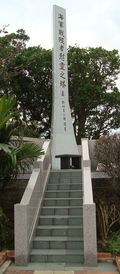 At my husband’s request, the family took a trip to what is now called The Former Japanese Navy Underground Headquarters. Knowing the grim history, I was a little hesitant to spend my Saturday (and take my children) to a place that essentially became a tomb for General Minoru Ota and his men. In the end, I’m really glad we did.
At my husband’s request, the family took a trip to what is now called The Former Japanese Navy Underground Headquarters. Knowing the grim history, I was a little hesitant to spend my Saturday (and take my children) to a place that essentially became a tomb for General Minoru Ota and his men. In the end, I’m really glad we did.
The first striking thing about our trip was the view! The entrance is at the top of a hill and there is a wooden platform that gets you an even better look around. It could definitely compete for one of the best views in Okinawa. There is also a beautiful memorial monument set up near the entrance.
Inside the Headquarters there is a museum as well as the tunnels themselves. The museum has a complete translation of the message left by Admiral Ota just before he killed himself. I definitely recommend spending the time to read this. In this message, General Ota details the sacrifice of the Okinawan people and asks that they be given “special consideration” by the Japanese government.
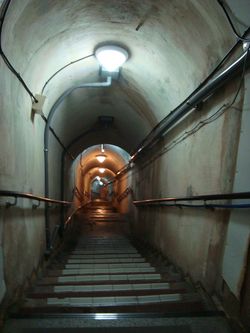 After the museum, head down the 30 meters or so of stairs to the tunnels. Walking through the corridors, it really strikes you how much intense work was put into digging out these tunnels and caves considering it was all done by hand. You can distinctly see the marks left by the pick axes.
After the museum, head down the 30 meters or so of stairs to the tunnels. Walking through the corridors, it really strikes you how much intense work was put into digging out these tunnels and caves considering it was all done by hand. You can distinctly see the marks left by the pick axes.
Not all of the Headquarters has been restored, but you can walk through about 300 meters of the original 450 meters. Among the rooms, there is the Commanding Officer’s room where General Ota left his final message and a staff room where you can clearly see the holes in the walls left by the shrapnel from a hand grenade when someone committed suicide.
We did this trip with a 7 year old and a two year old and I was surprised by how well they both did. My youngest loved exploring the “big caves” and my oldest was pretty interested in reading the signs (most have English translations) and seeing the photographs lining many of the walls. I was a little concerned how my daughter would react to the “shrapnel” room but she somberly took it all in. While there are ramps that will take you up to the entrance at the top of the hill and an elevator down to the museum/tunnels, I would NOT recommend taking a stroller in. There are about a hundred stairs down to the actual tunnels and stairs that lead to many of the room. The corridors also got pretty narrow in some spots.
There is a small souvenir shop and restrooms at the tunnel exit.
Price: There was an entrance fee of 420 yen for adults and 210 yen for elementary and junior high students (yen only). Small children are free.
Hours: The park is open year round from 8:30 in the morning to 5 at night.
Directions: Finding the Navy Underground Headquarters is a little dicey. We took the 58 south heading from Kadena towards Naha. We took a left onto rte. 7 where there was a sign and followed that up the road until we saw another sign telling us to turn left. At the end of this road there is a T intersection with a parking garage in front of you. We turned left, followed the road uphill and around a small bend to a parking lot at the bottom of some stairs. Parking here was free but the lot was small and could get crowded during the busier times of year. There were a handful of handicap spots up the road and closer to the entrance.


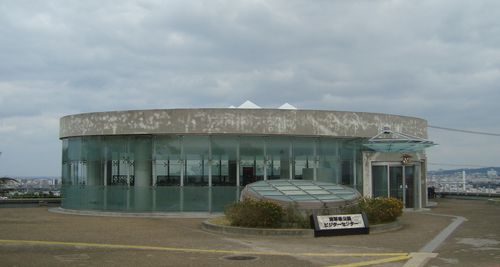

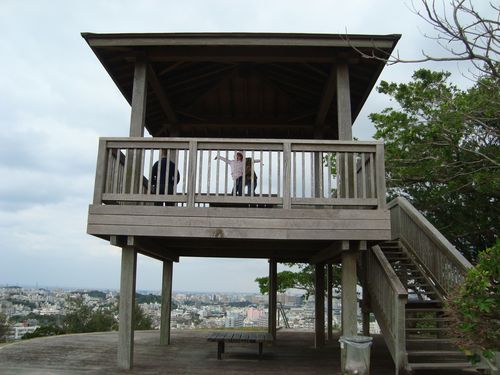
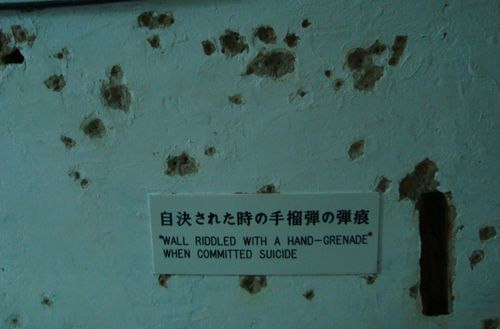
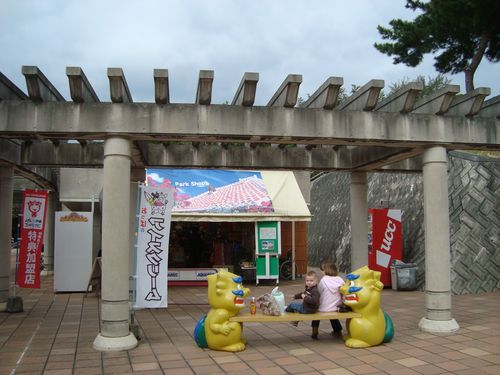
Are you sure all of the information is true
I spent my teen years at Naha Air Base in the mid 60s. One of my friends was digging a flower bed for his mom when he found and uncovered an iron door. He studied the base records of Japanese defences and found it was an entrance to the Navy HQ, and was a tomb for hundreds. The report also warned it may be bobby traped. My friend reburyed the door.
My name is rick chambers I lived on okinawa inthe mid 60s we went into caves and collected lots of stuff until the eod raided our house on kadena air base and took everything.
I remember hearing about that. I lived was born on Okinawa in 1956 and lived there till 1972.
How long should you plan for a visit to be?
I would allow one hour for the visit. If you can get someone to translate, it is best: There is a great deal of history and importance in this now-urban museum and the caves.
Very nicely done Matt and Amy. Keep it up
I was there in 1992 and have a document which tell about the cave. It says that 4000 Japanese sailor’s attached to this site committed suicide. An honorable death compared to surrender.
Really difficult to find, I got diverted by GPS, and was very wondered even when showing the name of the location in Japanese that most local people where clueless. But I had the same experience some time ago when trying to get to Auswitch by car.
We just went there and got slightly lost because all the tourists signs were hidden by trees. Here are much easier directions:
1. Take 58 towards Naha
2. Turn left on Rt 7
3. Drive through a tunnel
4. Turn left at the next light; you’ll see Pizza House Jr on the right at that corner.
5. Turn left at the dead end and follow the road up the hill. Half of the road will be red which will indicate that you are near the site. There is a lot right as the red road curves to the right and there is another parking lot at top near the entrance.
Thanks for posting this, including pictures. I enjoy WW2 history and don’t know if I will get to fulfill the dream of traveling to all these places to visit. So everyone’s posted pics on the internet will have to do for now. thanks again.
Im here, it is a waste of historical time…
Why do you say that, explain why it is a waste of time?
an amusement park.
tried to find this place drove circles though apartnent buildung parking lots finnaly gave up this place is def off the grid lol
i went there today, and it`s really interesting!!!
We did the museum today and were pleasantly surprised to find a great park at the bottom of the hill. If you aren’t pressed for time, there’s a small parking lot on your right as you leave the museum parking area. Park there and cross the street for the two intertwined roller slides as well as other great features.
I believe all the tunnels and most caves that weren’t natural were dug by Okinawan slave labour as two mamasans that ran the laundry in my barracks and the one adjacent had been recruited as young girls to carry heavy stones and rubble from the excavations. They seemed quite proud of what they did, but said the soldiers talk of how the american marines would treat them scared them a lot.
I was stationed a t Torii in 1970 , my house boy told us that they were forced into the army if they were old enough and the rest were forced to work for them. He said many died from the work and lack of food. He hated the japs.
Just wanted to add some directions that were easy for us:
-Take the expressway south as though you are going to Naha airport
-Get off of A-3, toward Tomoshiro
-Take a right onto Rte 7
-Follow signs to Navy HQ. It’s very close!
Here are other directions I found:
HOW TO GET THERE: Take Hwy 58 south past
Naha and over Meiji Bridge, turn left onto Rte 7 at the Yamashita intersection (across from Naha Military Port entrance). About 2.5 km down, the road curves and there is a road on the right, across the street from a botanical garden. Take this road (it goes up a hill), turn right, then veer right at a fork in the road to the parking lot of the headquarters.
Bill, I just went on a field trip there, and I THINK the tour guide said that a lot of Okinawans dug the tunnels, with crude shovels and picks, things like that. I could be wrong (the guide talked, A LOT and I didn’t catch it all!) Please don’t hold me to that, but I’m pretty sure that’s what he said 🙂
“Japanese Navy Corps of Engineers dug a 450 meter tunnel complex”
Just curious. Was it explicit that it was dug by Japanese labor? The only reason I ask is because the Navy yard in Guam has a series of tunnels dug after Japanese occupation which served as their HQ and hospital. The plaque stated that the tunnels were hand dug by Chamorro and Korean slaves.
Just curious to see how much truth the Japanese historians will divulge.
It depends on where you go; peace prayer park has a display for the thousands of Koreans used as slaves for tunnel building in Okinawa. There is no mention of them at the Naval underground.
The Japanese Navy engineers were in charge, of the engineering portion of the project. But there’s plenty of evidence based on personal oral histories that the Japanese used slave labor exclusively on no matter what kind of engineering project they were doing during the war time. Whether it was digging for a call on mainland Japain building railroads in Burma, or The headquarters bunker on Tarawa. Individual fighting positions would be dug by army or navy landing forces, but anything major Like an airfield was all slave labor. They even had a large amount of female mostly Korean for sex slaves.
Yes.